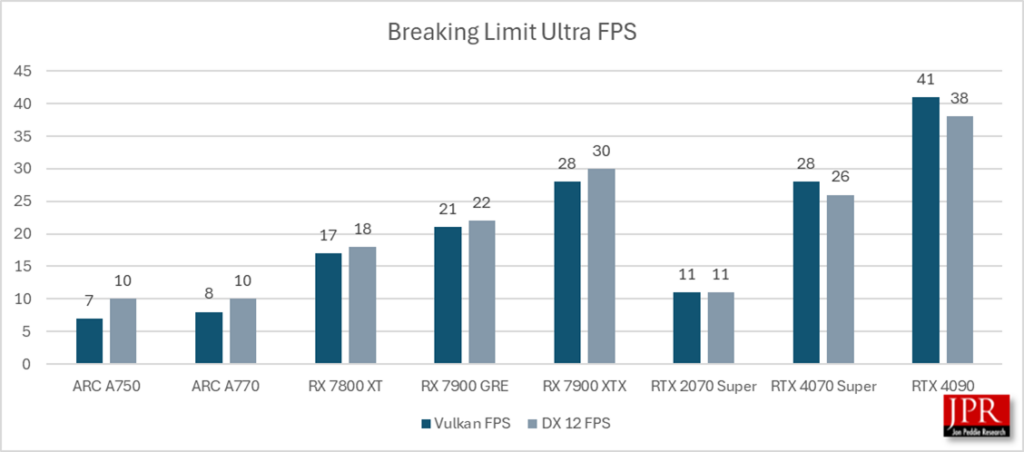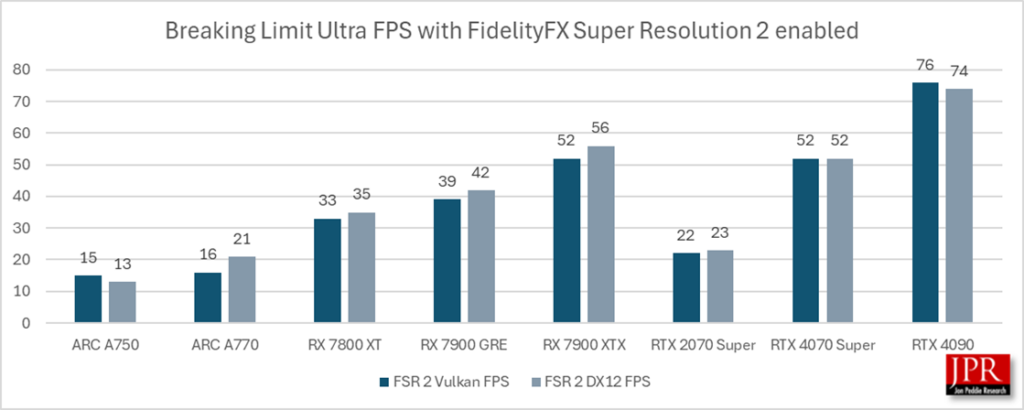Earlier this month, Basemark released two versions of Breaking Limit, a ray-traced-focused benchmark. Basemark’s Breaking Limit cross-platform benchmark is intended to test ray-tracing capabilities on a variety of platforms, including desktops, laptops, and smartphones. The benchmark includes two workloads: a regular workload for lower-end devices and a dedicated workload for high-end GPUs. Breaking Limit Ultra is a demanding task designed for desktop PCs with high-end discrete GPUs. Breaking Limit Ultra employs raytraced reflections and raytraced shadows. In addition to those, it uses raytraced global illumination. Raytraced reflections use a greater resolution than the cross-platform workload, and more lights are raytraced to create shadows. The resolution for reflections is the same as the primary rendering resolution, which is 3840×2160. Shadows from up to eight light sources are raytraced per frame.
This workload contains an average of 2.5 million triangles in the camera frustum, 49 shadow-casting light sources, and a total GPU memory use of around 6GB.

What do we think? We tested eight graphics add-in boards using Breaking Point Ultra, and the only graphics card to exceed 40 FPS was the RTX 4090. Breaking Point is a demanding test for graphics cards across all segments. One of our favorite features of Breaking Point Ultra is the ability to run the tests using multiple APIs along with different scaling software; both FidelityFX Super Resolution 2 (FSR 2) as well as DLSS 2 are included in the new benchmark.
Evaluating the Breaking Limit benchmark
Real-time ray tracing is a key technology for achieving real-time graphics realism. Real-time ray tracing has had a tremendous impact on desktop environments, setting the stage for future technological advancements. Breaking Limit Ultra is a demanding test that can push the limits of today’s GPU ray-tracing processing capability. We compared eight graphics cards using Basemark’s new benchmark.
Testing
Our test bed consists of:
CPU: 3.0 GHz Intel 13th Gen Core i9-13900K
MB: Asus Tuf Gaming Z790-Plus
Drives: CT500MX500SSD1 hard drive (500.11GB) – Drive 0, S/N 1902E1E1EF56, Rev M3CR023,
Samsung SSD 960 Pro 512GB
RAM: 32MB Corsair Vengeance
OS: Windows 11 Pro – 10.0.22621
RAM: DDR 4 3600

We tested eight graphics add-in boards using Breaking Limit Ultra official run, using both Vulkan and DirectX 12 APIs. The rendering resolution of the official benchmark is 3840×2160 (UHD).

Breaking Limit Ultra employs raytraced reflections and raytraced shadows. These techniques prove to be quite taxing on the latest graphics cards with only the ultra high-end RTX 4090 breaking 40 frames per second.
Testing with upscale software
Basemark has included Nvidia’s DLSS 2 and AMD’s FidelityFX Super Resolution 2 (FSR 2) upscaling software, which are only available on the Breaking Limit Ultra test.
When you run either of the two tests, the identical material will be rendered twice: once in conventional rendering and once with upscaling. The sections chosen to be produced twice were based on the animation’s camera cuts.
The DLSS test uses the first half of the entire animation, whereas the FSR test uses the second half; thus, the two tests are not comparable when utilizing the official test modes.
The score is expressed as a percentage, indicating an increase in performance.


With FidelityFX Super Resolution software enabled, the performance of our graphics card suite increased dramatically, 120%-plus for some graphics cards.

Nvidia-based graphics cards performed slightly better with DLSS 2 enabled than FidelityFX Super Resolution 2.
Using cutting-edge techniques such ray-traced reflections, ray-traced shadows, and ray-traced global illumination, Breaking Limit Ultra puts a lot of stress on current-generation GPUs, from the ultra high end to the midrange. Current-generation entry-level cards as well as previous-generation midrange AIBs have a very difficult time running Basemark’s new ray-tracing benchmark.